Related Research Articles

Yahweh was the national god of the kingdoms of Israel (Samaria) and Judah, with origins reaching at least to the early Iron Age and apparently to the Late Bronze Age. In the oldest biblical literature he is a storm-and-warrior deity who leads the heavenly army against Israel's enemies; at that time the Israelites worshipped him alongside a variety of Canaanite gods and goddesses, including El, Asherah and Baal, but in later centuries El and Yahweh became conflated and El-linked epithets such as El Shaddai came to be applied to Yahweh alone, and other gods and goddesses such as Baal and Asherah were absorbed into the Yahwistic religion.
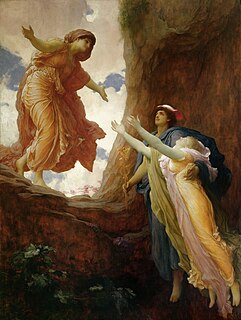
A dying-and-rising, death-rebirth, or resurrection deity is a religious motif in which a god or goddess dies and is resurrected. Examples of gods who die and later return to life are most often cited from the religions of the ancient Near East, and traditions influenced by them include Biblical and Greco-Roman mythology and by extension Christianity. The concept of a dying-and-rising god was first proposed in comparative mythology by James Frazer's seminal The Golden Bough (1890). Frazer associated the motif with fertility rites surrounding the yearly cycle of vegetation. Frazer cited the examples of Osiris, Tammuz, Adonis and Attis, Dionysus and Jesus.
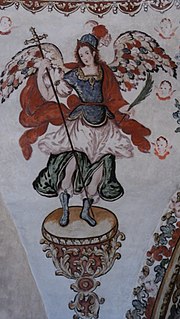
Comparative religion is the branch of the study of religions concerned with the systematic comparison of the doctrines and practices, themes and impacts of the world's religions. In general the comparative study of religion yields a deeper understanding of the fundamental philosophical concerns of religion such as ethics, metaphysics and the nature and forms of salvation. Studying such material facilitates a broadened and more sophisticated understanding of human beliefs and practices regarding the sacred, numinous, spiritual and divine.

Ugarit was an ancient port city in northern Syria, in the outskirts of modern Latakia, discovered by accident in 1928 together with the Ugaritic texts. Its ruins are often called Ras Shamra after the headland where they lie.

The Law of Moses, also called the Mosaic Law, primarily refers to the Torah or the first five books of the Hebrew Bible. They were traditionally believed to have been written by Moses, but most academics now believe they had many authors.

Wisdom literature is a genre of literature common in the ancient Near East. It consists of statements by sages and the wise that offer teachings about divinity and virtue. Although this genre uses techniques of traditional oral storytelling, it was disseminated in written form.
Ancient Semitic religion encompasses the polytheistic religions of the Semitic peoples from the ancient Near East and Northeast Africa. Since the term Semitic itself represents a rough category when referring to cultures, as opposed to languages, the definitive bounds of the term "ancient Semitic religion" are only approximate.
The religions of the ancient Near East were mostly polytheistic, with some examples of monolatry. Some scholars believe that the similarities between these religions indicate that the religions are related, a belief known as patternism.
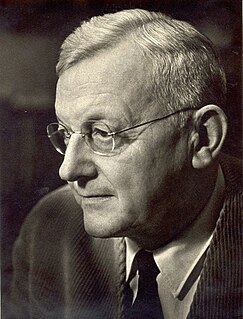
Gerhard von Rad was a German academic, Old Testament scholar, Lutheran theologian, exegete and University of Heidelberg professor.
Jimmy Jack McBee Roberts, known as J. J. M. Roberts, is William Henry Green Professor of Old Testament Literature (Emeritus) at Princeton Theological Seminary in Princeton, New Jersey. A member of the Churches of Christ, Roberts attended Abilene Christian University before pursuing doctoral work at Harvard University.
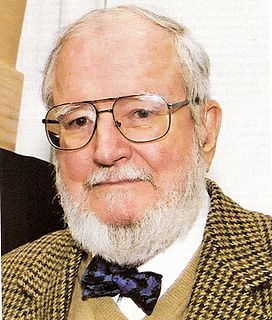
Frank Moore Cross Jr. (1921–2012) was the Hancock Professor of Hebrew and Other Oriental Languages Emeritus at Harvard University, notable for his work in the interpretation of the Dead Sea Scrolls, his 1973 magnum opusCanaanite Myth and Hebrew Epic, and his work in Northwest Semitic epigraphy. Many of his essays on the latter topic have since been collected in Leaves from an Epigrapher's Notebook.
John Duncan Martin Derrett was Professor of Oriental Laws in the University of London, from 1965 to 1982, and afterwards Emeritus Professor.
The Schweich Lectures on Biblical Archaeology are a series of lectures delivered and published under the auspices of the British Academy. The Leopold Schweich Trust Fund, set up in 1907, was a gift from Miss Constance Schweich in memory of her father. It provided for three public lectures to be delivered annually on subjects related to ‘the archaeology, art, history, languages and literature of Ancient Civilization with reference to Biblical Study’. The three papers given by each lecturer are published together in book form, by Oxford University Press. There have been many reprintings.
The origins of Judaism according to the current historical view, lie in the Bronze Age amidst polytheistic ancient Semitic religions, specifically evolving out of Ancient Canaanite polytheism, then co-existing with Babylonian religion, and syncretizing elements of Babylonian belief into the worship of Yahweh as reflected in the early prophetic books of the Hebrew Bible.
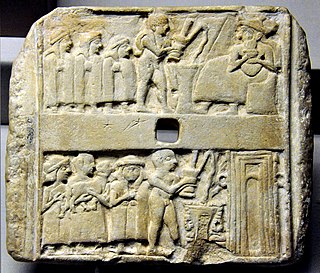
Sumerian religion was the religion practiced and adhered to by the people of Sumer, the first literate civilization of ancient Mesopotamia. The Sumerians regarded their divinities as responsible for all matters pertaining to the natural and social orders.
David Michael Rohl is a British Egyptologist and former director of the Institute for the Study of Interdisciplinary Sciences (ISIS) who from the 1980s has put forward several unconventional theories revising the chronology of Ancient Egypt and Israel to form an alternative new chronology.
The history of religions school is a term applied to a group of German Protestant theologians associated with the University of Göttingen in the 1890s.
Patrick D. Miller, Jr. was an American Old Testament scholar who served as Charles T. Haley Professor of Old Testament Theology at Princeton Theological Seminary from 1984 to 2005. He was an ordained minister in the Presbyterian Church (U.S.A.).

Martti Heikki Nissinen is a Finnish theologian, serving since 2007 as Professor of Old Testament studies in the Faculty of Theology at the University of Helsinki. He is known as an expert of the prophetic phenomenon in the Hebrew Bible and the ancient Near East, but his research interests include also gender issues in the ancient Eastern Mediterranean. He has written and edited several books and a significant number of articles on topics related to prophecy, gender, and history of ancient Near Eastern religion.

Yahwism was the religion of the ancient kingdoms of Judah and Israel (Samaria), centered around the Israelite deity Yahweh. Yahweh was one of many gods and goddesses of the pantheon of gods of the Land of Canaan, the southern portion of which would later come to be called the Land of Israel. Yahwism existed parallel to Canaanite polytheism, and in turn was the monolatristic, primitive predecessor stage of modern Judaism, in its evolution into a monotheistic religion.
References
- ↑ Samuel H. Hooke (1970). The Siege Perilous: Essays in Biblical Anthropology and Kindred Subjects. Ayer Publishing. p. 174. ISBN 0-8369-5525-0.
- ↑ Ivan Engnell (1969). A Rigid Scrutiny: Critical Essays on the Old Testament. Vanderbilt University Press. p. 23.
- ↑ Ivan Engnell (1960). "Methodological Aspects of Old Testament Study". Supplements to Vetus Testamentum. E.J. Brill: 18.